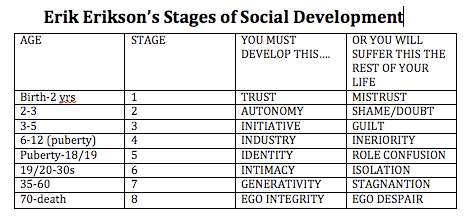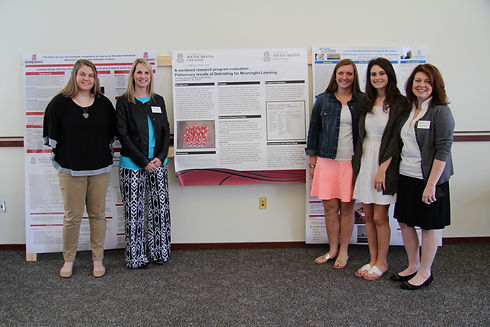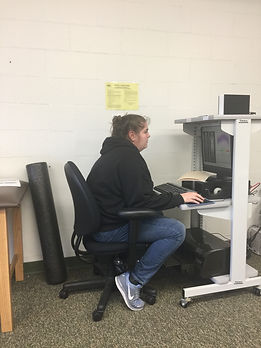Knowing your Inner Self
Theorist Erik Erikson believed that human beings develop by going through 8 developmental stages through their lifetime. His fifth stage, identity vs. role confusion, occurs between the ages of 12 through 18. You will represent many “identities” in your lifetime, but these identities do not always represent who you really are. Some people will even spend their entire life trying to form to one identity, but this identity is not who their inner self truly is or what they represent. This is why finding who you are and your purpose in life is so important (McLeod, 2017). I experienced this role confusion for myself. I did not know what I wanted to do as a career when I grew up. I did not know what I wanted to be or the lifestyle that I wanted to live. When it came time for me to go to college I decided that I would go into nursing. I had an interest in sports medicine, but I did not want to be an athletic trainer. I finally decided on nursing solely because of the job security, the different options for careers, and because all the women in my family were successful nurses. My first year of college I went home many nights and debated on whether nursing was what I wanted to do as a life-long career. My mom and I had long nightly talks about myself and what would make me happy. At this point, I was just “going with the flow.”
Ms. Andrea Campbell is the career counselor here at the University of South Carolina Lancaster. She was giving a lecture for any interested faculty and staff titled “Knowing Yourself and Your Career is a Formula for Success!” I attended this lecture and Ms. Campbell further supported my statement of how finding who you are and your purpose is so important. She spoke about how different careers appeal to different people. A person’s individual interest, personality, values, and skills can determine whether they are successful and happy in their career path. She continued by stating to help find who you are and what you're interested in is to talk to people. This aspect is very important to me. I believe that reaching out to other people and speaking to other adults or people with experience can get you far in your journey of finding out who you truly are. I would not have found my love for research and the human body without reaching out to some teachers of mine to help get me involved. I would not have decided that the nursing career is for me if I would not have spoken to other health care professionals. Another aspect Ms. Campbell spoke about was if you reach out and speak to other people with more experience then you might get the opportunity to experience something such as an internship or job shadowing. For example, my mother is a nurse and I was speaking to her one day about my future career. She knew that I had an interest in emergency medicine and reached out to an old friend of hers. He is an emergency medical technician and he has given me the opportunity to do ride alongs with the EMS crew.
One of the personality indicators that Ms. Campbell mentioned was the Myers-Brigg test. As a freshman, I was required to take a University 101 class to ease me into the college transition. One of our assignments was to talk to Ms. Andrea Campbell, the career counselor, about completing this Myers-Briggs personality indicator. My Myers-Briggs test indicated that I have an introverted, sensing, thinking, and judging personality. As an “introvert” I think and reflect on things before I act on them and I am very effective in roles that require logic. As a “sensing” person, I live in the now and pay attention to present opportunity, I use common sense and facts to solve problems, and I improvise based on past experiences and logic. As a “thinking” person, I search for facts and logic in a decision situation, I naturally notice tasks and work to be accomplished, and I accept conflict as natural. As a “judging” person, I like to plan details in advance before moving into action, works best when ahead of deadlines, and naturally uses calendars. After really studying my indicated personality and thinking more about my results I was very pleased. I felt that these personality indicators describe me very well. These qualities would also be very helpful in a nursing profession because nursing requires the ability to think in the moment about a patient’s signs and symptoms and use knowledge and proven facts to diagnose and treat the patient. There will also be conflicts in a health care setting and I must be able to accept this and work towards a solution. This personality assessment helped me solidify that nursing was what I was meant to do.
Also as a freshman student, one of the basic education classes that I was required to take was Human Anatomy and Physiology I (BIOL 243). I took an anatomy class my senior year of high school, but it was a really easy and with the basic material. I knew that this college-level course was going to be more in depth and more accelerated so I was nervous. Throughout the semester my lowest test grade was a 96. The class was so interesting and mind-blowing. I had found my passion and love for the human anatomy that semester and the passion grew as I took the next level of anatomy the next semester.
As I mentioned in my Ket Insight 2, Overcoming Your Fear of Speaking, I was given the opportunity to give a presentation to grant recipients on hypertension. Although this beyond the class experience helped me improve my public speaking it was also a teaching opportunity that helped me further notice my love for the human body. When researching the disease of hypertension prior to my presentation I was so intrigued by how the human body works so perfectly in sync and if a disorder such as hypertension come along, everybody process can be thrown off. I really felt good being able to educate these people on their body and their health. With my newly learned passion for anatomy and health care, I believe that I will be in the right profession and enjoy what I do as a career.
Through the nursing program at the University of South Carolina Lancaster, I was presented an opportunity to work on a research project mentored by Dr. Courtney Cateldge. The study was to test the lung capacity of middle school band students every school semester to determine if playing a wind instrument could be a possible treatment for asthma patients. At first, this study did not seem very intriguing to me. I had no interest in learning about asthma. After thinking about this opportunity, I decided to take advantage of it. As a research assistant in this study, I was responsible for learning how to use technology to take the lung test, explaining to student about the research we were conducting and how they would be helping, for coordinating how the equipment would make it to the school, coordinating who would work what equipment, and most importantly, contacting band instructors to schedule dates. At the beginning of the project, I was not sure it was something I wanted to spend my extra time participating in. After a few visits to the participating middle schools, I really began to enjoy it. The middle school students were so interested in the project and loved participating. I really enjoying working with these middle schoolers and teaching them all about their health, vital signs, and asthma. I also really enjoyed collecting and analyzing the data we collected. It is so interesting and worth while when you get all of your data analyzed and get answers to your hypothesis.
Finding my love for health care and determining that nursing was the right path for me, I still had many problems with the health care system and some of the errors that are being made. I am using the research opportunities given to me as not only a way to get my foot into the door of the research world, but to also learn more about research. As I progress in my career I would like to continue my research and use it to discover ways to improve malpractice and the quality of health care. Some research opportunities that I have had thus far include working with mentors Dr. Elizabeth Easley and Dr. Sarah Sellhorst to collect data and determine if body mass index (BMI) accurately categorizes obesity status. I have always had a problem with BMI and how it is such a widely used classification tool, but through this research, I have learned that BMI does not take into consideration a person’s visceral adipose tissue (VAT) and total body fat, therefore it has the potential to misclassify obesity status. This study has helped me understand the process of collecting and coding data, it has helped me learn how to interact with participants, it has helped me get a better understanding of HIPPA laws which will be practiced strictly in nursing, it has helped me learn how to write an abstract, how to create a poster, and how to present my findings to other people.
I feel lucky to have truly identified what my purpose in life is. I believe that I have chosen a profession that will make me excited to go to work every day and I know that is not the case for everyone. Being able to enjoy my work and the health care profession will be a major motivation for me to continue research to improve the field I love.



1. Campbell, A. (2017). Knowing Yourself and Your Career is a Formula for Success. Lecture. USCL
2. McLeod, S. (2017). Erik Erikson. Retrieved from https://simplypsychology.org/Erik-Erikson.html
3. Morton, S. (2013, April 11). Erik Erikson's Stages of Social Development [Online Image]. Retrieved from https://creatingtheidealclassroom.wordpress.com/2013/04/11/erik-eriksons-stages-of-social-development/
Morton, S. (2013, April 11). Erik Erikson's Stages of Social Development [Online Image]. Retrieved from https://creatingtheidealclassroom.wordpress.com/2013/04/11/erik-eriksons-stages-of-social-development/
Pictured above, I am standing with my teacher mentors, Dr. Catledge and Dr. Estrada, and some student researchers who participated in the BSN research.
Photo Credit: Shana Dry
Finding my love for heath care, I used my research opportunities to research some problems that I found in the health care system. Here I am pictured using the iDXA machine to measure participants total body fat and visceral adipose tissue.
